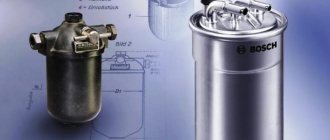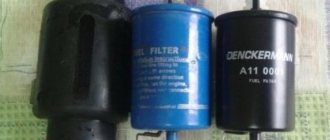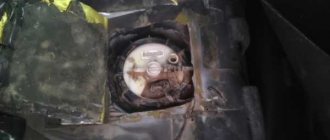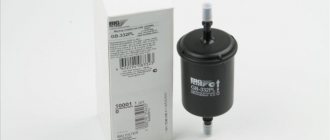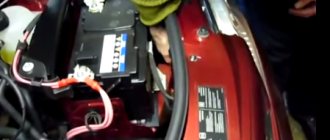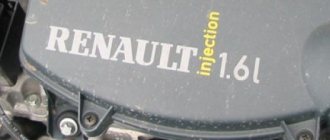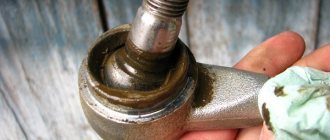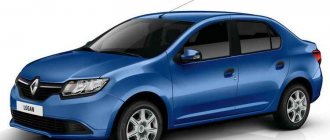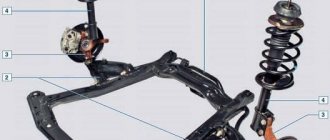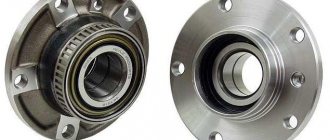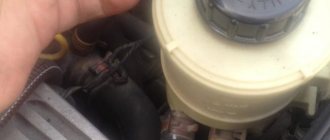how to change a fuel filter ⋆ I Love My Car
Renault Logan cars are widespread on our roads. Both generations of both the sedan and its high variant, Renault Sandero, achieved success. The cars are reliable, do not require frequent repairs, and are ideal for use on our roads. A budget car that copes with adverse conditions, while being quite comfortable and roomy for the money. But, whatever one may say, any car is subject to some breakdowns. It often happens that the cause of this is a problem with the fuel filter. Replacing the fuel filter will help solve a lot of problems with the power system.
Where is the fine filter located, symptoms of malfunction
The filter is located under the bottom near the gas tank
The fuel filter itself is a rather complex system. Essentially an ordinary consumable, of which there are dozens in Logan, because when it wears out it belongs to a replacement. The filter carries out fine cleaning of the fuel, accumulating sand, dust, other small fractions and condensate. When there are too many of them, the fuel module ceases to create sufficient pressure in the system. The fine filter is located under the bottom in the area of the gas tank. We can find it without difficulty. In addition, the gas tank also has a coarse filter and a mesh, which can also be changed if necessary, but for this you need to know how to remove the fuel module and fuel pump on a Logan. This filter clogs less frequently and is usually used in cases where the fuel pump stops working or is unstable.
Fine filter dimensions
We can guess that the fuel filter is clogged not only by looking at the service book and assessing the mileage. The main signs of a worn filter element are interruptions in engine operation:
When to change the filter in Renault Logan 1
According to the manufacturer for Renault Logan, the fuel filter must be replaced every 120,000 km. But you need to take into account that the filter needs to be changed not at a certain time, but at the moment the filter wears out. Due to poor fuel quality, the shelf life of the filter can be reduced by half or even three times, so experts recommend changing it every 40-45 thousand mileage. With timely replacement, we will protect ourselves from serious problems associated with the engine fuel supply system. Therefore, when the first problems listed above appear, you need to replace the filter. You can replace the filter yourself or by contacting a service center. To change the filter on Logan with your own hands, you need to know the sequence of actions and choose the right filter to replace.
Which fine filter is better, articles and prices
SCT filter, optimal in price and quality
You can purchase original parts from the official manufacturer that are installed at the factory. Their articles are: 6001546326, 7700845973, 7701068107. Their cost is low - $7-9. The original cannot cost less than $7; filters with a low price turn out to be fake. Such filters will not be able to filter fuel, which leads to failure of injectors and other elements of the fuel system. Original filter for Logan
Analogues:
- GOODWILL. Catalog number: FG 300. A common budget analogue of the original. This filter receives positive reviews and has a decent service life. Its price is $6.8.
- FRANCECAR. Article: FCR210130. Also a practical analogue, drivers have no complaints, the cost is about $6-7.
- SCT. Article: ST 393. Universal filter, suitable for many cars. $5.
- BOSCH. Article number: 0 450 905287. The most expensive, at the same time high-quality and long-lasting filter. $17.
- NISSAN. Article: 16400JD51A. Buyers are satisfied with the quality of this filter; it is ideal for Renault Logan. $13.
- HYUNDAI. Article: 31911-3A000. Versatile and practical, the most environmentally friendly among those presented. Up to $15.
How to change the filter with your own hands, relieve pressure
We are preparing the system for replacement. Before replacing the filter on Logan, you need to lower the pressure in the fuel system. For this:
- With the ignition off, you need to lift the hood lid.
- You need to remove the negative terminal from the battery using a screwdriver and a 10 mm wrench.
- Open the relay block cover near the battery.
- After this, remove the pump relay. The back of the cover shows the location for installing the relay.
- The terminal needs to be installed back.
- Start the car and wait 3 minutes. The engine should stall on its own. The pressure drops because fuel is not entering the fuel rail.
- The ignition must be turned off.
- Remove the negative terminal from the battery again.
Replacing the fuel filter. Work algorithm
- The Renault Logan fuel filter is located at the bottom of the car, next to the tank. In this case, it is not necessary to use an inspection hole or overpass. It is available for replacement without special equipment.
- It and the tubes need to be cleaned of dirt. This will make replacement easier.
- Disconnect the pipeline while keeping the red lock pressed.
- Pour the remaining gasoline into a separate container.
- We disconnect it from the second side, clamping the green clamp.
- The filter is attached with a clamp, loosen it and take out the filter.
- Install a new filter. There is an arrow on the body; its direction should coincide with the direction of fuel supply in the system. To avoid mistakes, you can look at the direction on the old filter.
- Snap both tips tightly.
- The pump relay must be installed back, not forgetting the terminal.
Replacing a fuel filter on a Renault Logan is not as difficult as it might seem. You just need to know its location and have enough time. In any service, this process takes no more than fifteen minutes, but the cost of replacement work will be approximately equal to the price of a new good filter. Replacing the fuel filter with your own hands will allow you to forget about visits to the service station for trifles and save a lot of time and money. At the same time, if the filter is not replaced, you will have to put up with huge fuel consumption, after which you will have to pay an amount many times greater than the cost of the filter to repair the car. Clean gasoline and smooth roads to everyone!
Popular in the section
i-love-mycar.com
Fuel filter Renault Logan
To clean the fuel supplied to the engine, the Renault Logan design provides a fuel filter.
During operation, the consumable loses its throughput as it becomes clogged with debris. To solve the problem, it is necessary to replace the old filter. It's not particularly difficult to do it yourself. Initially, the Renault Logan car was equipped with a separate fine fuel filter. He had no alternative until 2006. The original consumable has article number 6001546326. However, Renault does not manufacture fuel filters on its own. It purchases and packages Bosch products. The direct analogue produced has catalog number 0450902161.
Some Renault Logan cars use an original fine fuel filter with article number 7700845961. It is also not manufactured by Renault. Consumables are purchased from MecaFiltre. Therefore, a direct analogue with catalog number ELE6015 is available for sale.
When purchasing fuel filters in original Renault packaging, you will need to pay 350-500 rubles for consumables. Direct analogues have a lower price. Their cost varies from 300 to 400 rubles.
At the same time, car owners note that the Bosch filter is better in quality and performance characteristics than MecaFiltre, despite almost the same price. Therefore, drivers recommend purchasing the original 6001546326 or a direct analogue 0450902161 produced by Bosch.
If it is not possible to buy a direct analogue or original, you should pay attention to products from third-party manufacturers. The table below presents the best alternatives to branded consumables.
Table - Analogs of a free-standing fine fuel filter for a Renault Logan car
| Company manufacturer | Article number | Estimated cost, ruble |
| Ford | 1137449 | 1500-2000 |
| WIX | WF8034 | 160-200 |
| JC Premium | B4R029PR2X | 220-250 |
| Knecht-Mahle | KL4161 | 300-370 |
| Profit | 15300730 | 200-230 |
Since 2011, the Renault Logan has finally lost its free-standing filter. It was moved to the fuel cup. The filter does not have its own article number and, according to official statements from the manufacturer, it should be replaced together with the module.
The original fuel cup has article number 6001547604 and costs 6,000-14,000 rubles. Since the price of a branded module is high, drivers buy its analogues. The table below presents a list of the best alternatives to native consumables.
Table - Alternatives to fuel modules with a built-in filter for a Renault Logan car
| ERA | 775176 | 4400-5600 |
| Manufacturer brand | Catalog number | Approximate price, ruble |
| Krauf | KR0867M | 2500-3000 |
| Bosch | 986580368 | 2400-3000 |
| Magneti Marelli | MAM00046M | 3000-4800 |
| Asam | 30290 | 3400-4900 |
The Renault Logan diesel car uses an original fuel filter with catalog number 164000884R. Its cost ranges from 1200 to 2580 rubles. You can get acquainted with good analogues of branded consumables in the table below.
Table - Analogs of fuel filters for Renault Logan diesel car
| Manufacturer brand | Catalog number | Approximate price, ruble |
| Delphi | HDF954 | 890-1000 |
| Champion | CFF100530 | 770-1000 |
| Profit | 15302823 | 660-890 |
| Bosch | F026402075 | 900-1500 |
| Shafer | FM781 | 440-350 |
where it is, photos and videos
To ensure stable operation of the car, it is necessary to carry out timely maintenance work. And timely replacement of the fuel filter serves as a guarantee of such work. Because a car with a certain mileage may require such a procedure at any most inconvenient moment.
- What is a fuel filter?
- Where is he located?
- And when should I change it?
You will learn more in our article!
Where is the fuel filter located in Renault Logan?
Read more about:
At the gas tank where the fuel pipes exit
On cars of the Logan family of the l generation (2005-2006) produced, the fuel filter was located at the gas tank at the exit of the fuel pipes, in the area of the rear wheel, on the right.
In the fuel pump housing
Inside the fuel pump (fuel pump)
If, during the inspection, you found that there is no filter there, this only means that your car was produced after the third quarter of 2006 and the filter is located directly in the gas tank, together with the fuel pump.
The fuel pump must be removed to gain full access to the filter.
And since this design is more reliable, it should be given a little less attention than usual.
Replacement process
Consider the option of replacing the Renault Logan external fuel filter.
While the engine is running, the fuel is under constant pressure, which remains even 2-3 hours after it stops. Therefore, if work to replace the filter is carried out a short period of time after startup, the pressure from the fuel line must be relieved.
- To do this, you will need to lift the rear seat and disconnect the wiring connector at the fuel pump.
Disconnecting the pump power
- Then start the engine and wait until the fuel remaining in the line burns out.
- Further, when the engine stalls for 4-5 seconds, we turn it with the starter, this will indicate the release of operating pressure from the fuel network.
- Disconnect the negative terminal from the battery.
- After making sure that the pressure has been released, you can proceed directly to the dismantling itself. On both sides of the filter, tips with red and green fasteners are fixed to the fittings. The order in which the pipes are removed does not matter in this case, but it is worth paying attention to the position of the arrow on the filter housing, which indicates the direction of fuel flow.
The installation process is similar in sequence to the removal process.
After replacement
When connecting all components of the fuel line and terminals to the battery, it is necessary to fill the entire system with fuel. To do this, turn on the ignition for 3-6 seconds, and the characteristic sound of the fuel pump will be heard. At this time, it is necessary to check the condition of the filter itself, as well as the pipes and clamps, for leaks.
What is the purpose of the fuel filter?
Fuel filter for Renault Logan in original packaging
The fuel filter is designed to prevent various deposits, dirt, and rust from entering the engine along with fuel from the fuel tank. And considering that the gasoline at some gas stations in our country is not of the best quality, the efficiency and necessity of such a device in the Renault Logan fuel line is simply necessary. Read more about what kind of gasoline should be used for this car in the article: Does Renault-Nissan recommend 92 or 95 gasoline?
According to official regulations from Renault, the fuel filter on Logan must be replaced every 120,000 kilometers. And the volume of the fuel tank is 50 liters.
This fuel filter had a mileage of only 50,000 km with a regulation of 120,000 km
However, as already mentioned above, the fact that Russian gasoline is not of the best quality, it is worth changing the filter several times more often. Thus, the approximate mark of 50,000 - 60,000 kilometers becomes the target and corresponds to the maintenance mileage.
Symptoms when you need to pay attention to the fuel filter
The first and main symptoms indicating that the fuel filter is clogged are jerking and instability of the engine when driving in any gear.
Nowadays, there are many models of fuel filters on the market, but you should only purchase those recommended by the manufacturer.
carfrance.ru
Design features of the power supply system Renault Logan 2004-2009 Gasoline
The power system includes elements of the following subsystems:
– fuel supply, which includes a fuel tank, electric fuel pump, fuel filter, fuel pressure regulator, pipelines and a fuel rail with injectors;
– air supply, which includes an air supply pipe, an air filter, a throttle assembly, and an idle air control;
– fuel vapor recovery, which includes an adsorber and connecting pipelines.
The functional purpose of the supply system is to ensure the supply of the required amount of fuel to the engine at all operating modes. The engines are equipped with an electronic engine management system with distributed fuel injection. In a distributed injection system, the functions of mixture formation and dosing of the air-fuel mixture into the engine cylinders are separated: air is supplied by an air supply system consisting of a throttle assembly and an idle speed regulator, and the amount of fuel required at each moment of engine operation is injected by injectors into the intake pipe. This control method makes it possible to ensure the optimal composition of the combustible mixture at each specific moment of engine operation, which allows you to obtain maximum power with the lowest possible fuel consumption and low exhaust gas toxicity. The fuel injection system (as well as the ignition system) is controlled by an electronic unit that continuously monitors, using appropriate sensors, the engine load, the speed of the vehicle, the thermal state of the engine, and the optimal combustion process in the engine cylinders.
The fuel vapor recovery system prevents the release of fuel vapors from the power system into the atmosphere, which adversely affect the environment.
The system uses the method of vapor absorption by a carbon adsorber. It is installed in the niche of the right front fender and is connected by pipelines to the fuel tank and inlet pipe. On the canister cover there is a solenoid valve for purge the canister, which, based on signals from the engine control unit, switches the operating modes of the system.
Fuel vapor from the fuel tank is constantly removed through a pipeline and accumulated in an adsorber filled with activated carbon (adsorbent). When the engine is running, the adsorbent is regenerated (restored) by purging the adsorber with fresh air entering the system under the influence of vacuum transmitted through a pipeline from the intake pipe to the adsorber cavity when the valve opens. The amount of valve opening, and therefore the intensity of purge of the adsorber, depends on the angle of rotation of the throttle valve and is determined by the vacuum that occurs in the cavity of the intake pipe of a running engine.
Fuel vapor from the adsorber enters the engine intake pipe through a pipeline and burns in the cylinders.
Malfunctions of the fuel vapor recovery system lead to unstable idling, engine stalling, increased toxicity of exhaust gases and deterioration of the vehicle's driving performance.
5.6. Diagram of the air-fuel mixture control circuit: 1 – oxygen concentration sensor in the exhaust gases (lambda probe); 2 – exhaust manifold; 3 – engine; 4 – nozzle; 5 – engine control unit; 6 – exhaust gas catalytic converter.
The main sensor for ensuring an optimal combustion process is the oxygen concentration sensor in the exhaust gases (lambda probe). It is installed in the engine exhaust manifold and, together with the electronic unit and injectors, forms a circuit for adjusting the composition of the air-fuel mixture supplied to the engine (Fig. 5.6). Based on sensor signals, the engine control unit determines the amount of unburned oxygen in the exhaust gases and accordingly evaluates the optimal composition of the air-fuel mixture entering the engine cylinders at each time. Having detected a deviation of the composition from the optimal 1:14 (fuel and air, respectively), which ensures the most efficient operation of the exhaust gas catalytic converter, the control unit changes the composition of the mixture using injectors. As a result, the air-fuel mixture control loop is closed.
Some vehicles have two oxygen concentration sensors: one in the exhaust manifold, the other behind the catalytic converter. The first sensor is control (based on its signal, the ECU adjusts the fuel supply), and the second is diagnostic (based on its signal, the ECU evaluates the efficiency of the catalytic converter).
The fuel tank , molded from petrol-resistant plastic, is installed under the floor of the body in its rear part and is secured with two bolts and two nuts. To prevent fuel vapors from entering the atmosphere, the tank is connected by a pipeline to the adsorber. An electric fuel pump is installed in the flange hole at the top of the tank. From the pump, fuel is supplied through a pressure regulator to the fuel filter installed at the end of the fuel tank, and from there it enters the engine fuel rail mounted on the inlet pipe. From the fuel rail, fuel is injected by injectors into the intake pipe.
The fuel lines of the power supply system are tubes that connect the various elements of the system.
WARNINGS
It is prohibited to replace steel pipelines with hoses, copper or aluminum tubes, since only steel pipelines meet the conditions of high pressure and vibration.
The hoses of the power supply system are made using a special technology from oil- and petrol-resistant materials. The use of hoses that differ in design from those recommended may lead to failure of the power system and, in some cases, to a fire.
In connections of pipelines with elements of the power supply system, round sealing rings are used. The use of seals of a different design is prohibited.
The fuel pump module includes an electric pump...
...a fuel pressure regulator that maintains constant fuel pressure in the central fuel channel
ramps in all engine operating modes and does not allow excess pressure in the fuel rail...
...and the fuel level sensor.
The fuel pump module provides fuel supply and is installed in the fuel tank, which reduces the possibility of vapor lock formation, since the fuel is supplied under pressure and not under vacuum.
Submersible fuel pump, electrically driven, rotary type. The pump of a non-demountable design cannot be repaired; if it fails, it must be replaced.
Fuel filter 1 (Fig. 5.7) is fine - full-flow, secured with a clamp 7 on the fuel tank in its front part. The filter is non-separable and consists of a steel body with a paper filter element.
5.7. Location of the fuel filter on the car: 1 – fuel filter; 2 – pipe ends; 3 – fuel supply line; 4 – fuel drain pipeline; 5 – fuel outlet line; 6 – fuel tank; 7 – fuel filter mounting clamp.
ramp 2 (Fig. 5.8) is a cast hollow part with holes for installing injectors 3 and with a supply fitting 5 for connecting the high pressure fuel line. The injectors are sealed in the sockets with rubber rings 4 and secured with spring clamps 1. The ramp with the injectors as an assembly is inserted with the injector shanks into the holes of the intake pipe and secured with two bolts.
5.8. Injector ramp: 1 – injector retainer; 2 – ramp; 3 – nozzle; 4 – nozzle sealing ring; 5 – fitting for connecting the high pressure fuel line.
The injectors (Fig. 5.9) are attached to the ramp from which fuel is supplied to them, and with their nozzles they enter the holes of the inlet pipe. In the openings of the ramp and inlet pipe, the injectors are sealed with rubber O-rings 1 and 2. The injector is designed for dosed injection of fuel into the engine cylinder and is a high-precision electromechanical valve. Pressurized fuel flows from the ramp through channels inside the injector body to the shut-off valve. The spring presses the shut-off valve needle against the conical hole of the spray plate, holding the valve in the closed position. The voltage supplied from the engine control unit through plug terminals 3 to the injector electromagnet winding creates a magnetic field in it, drawing the core together with the shut-off valve needle into the electromagnet. The conical annular hole in the nozzle plate opens and fuel is injected through the nozzle body diffuser into the inlet port of the cylinder head and then into the engine cylinder. After the electrical impulse stops, the spring returns the shut-off valve core and needle to their original state - the valve is locked. The amount of fuel injected by the injector depends on the duration of the electrical pulse.
5.9. Fuel injection system injector: 1 – upper sealing ring; 2 – lower sealing ring; 3 – plug terminals of the electromagnet winding.
Fuel pressure regulator installed in the fuel pump module maintains constant fuel pressure in the engine power system in all engine operating modes. The electric fuel pump delivers more than is needed to keep the system operational. Therefore, when the engine is running, part of the fuel is constantly drained into the fuel tank using a pressure regulator.
The air filter is installed in the center of the engine compartment.
The air filter filter element is paper, round, with a large filter surface area.
The throttle assembly is a simple control device and is used to change the amount of main air supplied to the engine intake system. It is installed on the inlet flange of the intake pipe. An air filter is placed on the inlet pipe of the throttle assembly; the connections of the throttle assembly with the inlet pipe and the air filter are sealed with rubber gaskets.
There is a hole in the throttle body to supply additional air to the idle air control.
5.10. Throttle assembly: 1 – idle speed regulator; 2 – throttle valve drive lever; 3 – throttle valve; 4 – throttle position sensor; 5 – throttle body.
In housing 5 (Fig. 5.10) there is a damper 3 that rotates on an axis. At one end of the axis there is a throttle position sensor 4 of the engine control system, at the other there is a lever 2, to which the intermediate rod of the throttle drive is connected. Idle speed regulator 1 is attached to housing 5, dosing the air flow when the throttle valve is closed.
During operation, the throttle assembly does not require maintenance or adjustment; just monitor the condition of the rubber seals to avoid air leaks.
The idle speed control maintains a set engine idle speed with the throttle valve fully closed during engine start-up, warm-up, and when load changes when auxiliary equipment is turned on.
The regulator changes the amount of additional air supplied to the intake system in addition to the throttle body, and is an electromechanical valve attached with two bolts to the throttle body flange. The regulator valve seat and channels made in the throttle assembly flange form a system for supplying additional air, bypassing the throttle valve.
5.11. Idle air control: 1 – valve; 2 – regulator body; 3 – stator winding; 4 – lead screw; 5 – plug terminal of the stator winding; 6 – ball bearing; 7 – stator winding housing; 8 – rotor; 9 – spring.
The engine control unit, having processed signals from the sensors, determines the need to open valve 1 (Fig. 5.11) of the regulator and transmits pulses to plug terminal 5 of winding 3 of the regulator stator. With each control pulse, the rotor 8 rotates at a certain angle, moving the valve 1 relative to the seat using the lead screw 4. Additional air enters the intake pipe through channels in the throttle assembly. By determining the vacuum in the engine intake pipe, the control unit strives to maintain it at a given level by periodically opening and closing the idle air control valve. This makes it possible to supply a constant amount of additional air to maintain a constant idle speed. By changing the amount of opening and closing of the regulator valve, the control unit compensates for a significant increase or decrease in the amount of supplied air caused by its suction through a leaky intake system or, conversely, by a clogged air filter.
The inclusion of additional units causes an increase in engine load, accompanied by a decrease in idle speed and a change in vacuum in the intake pipe, which is also compensated by the control unit using a regulator.
Source: https://vnx.su/content/avto/renault/logan/5-14-1-osobennosti-konstrukcii.html
Replacing the Renault Logan fuel filter
The fuel filter on Renault Logan, produced before the fall of 2006, is located under the bottom. It needs to be replaced every 30 thousand km. (1-1) And on models released later, the fuel filter is located directly in the gas tank. Such an element requires replacement after 120 thousand km. (1-2)
1-1 Replacing the Renault Logan fuel filter
1-2
Old models
1. Open the hood. Disconnect the “-” battery. We press the latches of the mounting block cover and remove it. (2)
2. We remove the fuel pump relay from the block, indicated in the photo K5. (3)
3. We connect the terminal, start the car and wait for the engine to stop on its own. This procedure is necessary to generate remaining fuel. After this, turn off the ignition and remove the terminal again.
4. We lift the car or drive it into a viewing hole. In the right rear part of the bottom we find the fuel filter. (4) We clean dirt from it.
5.Press the fasteners on both sides (red and green buttons) and disconnect the fuel line hoses. In this case, a small amount of gasoline may leak out, so it is better to substitute some kind of container. (5)
6.Remove the fuel filter from the mount. (6)
7.Install a new element. Pay attention to the arrow on the filter housing. It must be directed in accordance with the movement of fuel in the system. (7)
8.Place the fuel hoses until they click. There is no need to press the release buttons. (8) Reinstall the electrical components.
Turn on the ignition. Clicking sounds from the fuel pump will be heard for approximately 2–4 seconds. When they calm down, check the tightness of the connections.
New models
1.Remove the rear seat cushion to access the gas tank access hole. (9)
2.The arrow on the cover indicates the location of the latch. We pry it off with a screwdriver and move it to the side. (10)
3. Clean the surface from dirt. We take out the connector with wires. (eleven)
4.Press the lock on the tip of the fuel line and disconnect it. (a) Sometimes two hoses are connected to the block, we proceed in the same way. (b)
A
b
5.Use a puller to unscrew the retaining ring and remove it. (13)
6.Take out the rubber gasket and wipe it. Otherwise, in the air, under the influence of gasoline, it will swell, and its further operation will become impossible. (14)
7.Remove the fuel filter block. (15)
8.On Renault Logan it is impossible to replace the filter cartridge separately. Therefore, it is necessary to purchase the entire structure assembled. Only the coarse mesh can be replaced. You can also wash the fuel collection glass. (16)
We install all elements in reverse order.
Also watch a video on replacing the fuel filter on a Renault Logan:
filtrr.ru
Fuel filter location
A separate fuel filter is located on Renault Logan behind the right rear wheel. It is located under the gas tank, directly at the outlet of the fuel line.
On newer Renault Logan, the filter is built into the fuel cup, which is located in the gas tank.
On diesel Renault Logan, the filter is located in the engine compartment. It is located behind the front right wheel.
How to change the fuel filter on Renault Logan
The fine filter plays an important role in the fuel system of a Renault Logan car. It removes various contaminants from gasoline and is capable of maintaining long engine life. But, only under one condition - timely replacement of the old filter with a new one.
Location of the fuel filter on old and new Renault Logan models
On older Renault Logan models that came off the assembly line before the fall of 2006, the fuel filter was placed under the gas tank in the area of the right rear wheel, in the place where the fuel pipes exit the tank. For cars produced after the fall of 2006, the fuel filter began to be installed inside the fuel tank along with the fuel pump.
Frequency of replacing the Renault Logan fuel filter
According to the maintenance regulations, the fuel filter located inside the gas tank must be replaced every 120 km. In this case, not only the fine filter must be replaced, but also the fuel pump, since it is non-separable. The operation is quite complicated, so if you are not confident in your abilities, it is better to contact specialists.
Unfortunately, the quality of domestic gasoline does not meet international standards. Therefore, the recommended mileage figure from the manufacturer is far from Russian realities. It is better, following the opinion of experts, to replace it every 60-90 thousand kilometers.
In a situation where the fuel filter is located under the bottom of the car near the gas tank, it should be changed every 30 thousand km or at each regular technical inspection.
Signs of a clogged fuel filter
There is only one warning factor that can indicate a clogged fuel filter on a Renault Logan car. The car's dynamics will be disrupted and it will begin to move jerkily, regardless of the speed.
Choosing a fuel filter for Renault Logan
You can purchase a fuel filter for Renault Logan at any auto store, auto center, or order it online. The range of filters is quite diverse, both in terms of cost and manufacturer brands. When choosing a fuel filter for your “horse”, focus your attention on global brands such as Bosch and Mahle. Filters of these brands are well suited to the price/quality ratio. They can please you with excellent functionality and a very reasonable price of 10-15 USD.
Replacing the Renault Logan fuel filter
So, the time has come when you realized that you can no longer delay replacing the fuel filter and decided to carry out this operation yourself. Well, you have chosen the most optimal option, since replacing the cleaning element on an old Renault Logan model will not be difficult for you. But before you get down to business, stock up on the necessary tools and spare parts, and also familiarize yourself with fire safety techniques.
Fire safety rules
When working with the fuel system of a car, you must be extremely careful, since only preschool children are not aware of the explosive mixture of air and gasoline. Therefore, remove all open sources of fire in advance and open the garage doors to allow fresh air to enter. At the same time, you should not close the car doors, as the interior will be ventilated through them. If possible, it is better to carry out this operation in the open air.
Fuel filter replacement tools
- New filter
- Container for draining gasoline
- Set of open-end wrenches
- Rags
How to relieve pressure in the fuel system
To avoid accidentally taking a gasoline bath, before touching the fuel system, you must first release the pressure in it. If it is not possible to wait 3-4 hours after stopping the car, then proceed as follows.
- With the engine turned off, open and secure the hood cover.
- Remove the wire from the negative battery
- Remove the mounting block cover by pressing the left and right latches
- Take out the relay located in the pump mounting block (indicated by an arrow in the figure)
- Connect the wire to the negative side of the battery and start the engine until it stalls, having used up the remaining fuel.
- Next, turn off the ignition and disconnect the fuel hoses.
Instructions for replacing the fuel filter on older Renault Logan models
- At the first stage of work, in order to get to the fuel filter, we lift the car with a jack or drive it into an inspection hole.
- On the right side of the rear of the bottom we find the fuel filter. Using a special liquid “WD-40”, wipe off all the dirt with a rag.
- We install a container under the cleaning element to drain remaining gasoline
- On both sides, press the fixing ties (green and red button) and disconnect the tips of the fuel pipes.
- Pull back the clamp and remove the fuel filter from it.
- Install the new filter in reverse order. When installing, pay attention to the arrow on its body. It indicates the direction of fuel movement along the highway.
- Next, we put the tips of the tee and the fuel pipe onto the filter fittings until the clips snap into place.
- We connect the wiring harness block to the fuel module cover connector and the wire terminal to the negative terminal of the battery.
- To fill the system with fuel, start the engine. In this case, for 2 - 4 s you will hear the clicking sounds of the operating fuel pump. When the pump turns off, check the tightness of the connections of the fuel hoses and filter. We replace the tee and fuel pipe with damaged tips, faulty clamps and a filter with a leaky housing with new ones.
Instructions for replacing the fuel filter on new Renault Logan models
- We release the pressure in the fuel system.
- We remove the rear passenger seat to get to the gas tank access hole.
- On the gas tank cap we find an arrow that indicates the location of the latch. We pry it off with a flat screwdriver and move it to the side.
- We clean all the dirt from the surface and remove the connector with the wires.
- Squeeze the fixing tie on the tip of the fuel pipe and disconnect it. If two pipes are suitable for the block, we proceed in the same way.
- Next, use a puller to unscrew the O-ring and remove it.
- After removing the rubber gasket, be sure to wipe it. Otherwise, under the influence of fuel, it will swell and you will not be able to put it back in place.
- Remove the fuel filter block.
- As we already wrote above, the fine filter cannot be replaced separately from the fuel pump. Therefore, it is necessary to purchase the entire fuel module assembly. Only the coarse mesh can be replaced or blown out. You can also rinse the gasoline collection glass.
- Next, we install all the elements in the reverse order.
Conclusion
As you can see, there is nothing complicated in this operation, so if you wish, you can easily carry out the replacement yourself at home.
We draw your attention to the following video, with which you will more clearly examine the process of replacing the fuel filter on a Renault Logan.
filtrzamena.ru
Changing the part
Removing the old filter and, of course, installing a new one is carried out as follows:
- First you need to crawl under the car.
- After this, use a brush to completely clean the fuel assembly or blow it off with a pump. Don't forget about the pipelines that are connected to it.
- There is a red button on one side of the fuel filter. You need to click on it. This will allow us to detach the element we are interested in from the tube.
- Now you should remove the clamp, which acts as a support for the filter.
- Opposite the red button is a green one. You need to press it to detach the second tube from the filter.
- Now you can replace the part that has become unusable. To install a new fuel filter, you need to do all the above steps, but in reverse order.
How to replace the fuel filter in Renault Logan?
Share
924 AutoTube 07/14/2018 09/12/2018
12:52
According to technical regulations, the fuel filter on Renault Logan must be replaced every 30 thousand km. mileage on cars manufactured before the fall of 2006 and after 120 thousand km. mileage on second generation cars. However, given the quality of Russian fuel, it is recommended to update the fuel filter every 15 (60) thousand km. This will avoid possible future problems associated with the vehicle's fuel system. Models produced before 2006 of the first generation are equipped with an external fuel filter, which is located under the bottom. In new modifications, the fuel filter is located directly in the gas tank and the entire fuel module (fuel pump and filter) must be replaced. The main symptoms of a clogged filter: engine jerking when driving at high and low speeds, problems when starting, a drop in power under increased load, a sharp increase in fuel consumption. Replacing the fuel filter yourself requires the car owner to have certain knowledge, skills and tools, especially on second-generation cars. Therefore, if you are not sure that you can do everything correctly, it is better to immediately contact professionals at a car service center.
Attention! This video is not official
instructions and car repair manuals.
Renault Logan — Replacing the fuel filter and Fuel Level Sensor (FLS)
Renault Logan — Replacing the fuel filter and Fuel Level Sensor (FLS). Subscribe to my channel https://www.youtube.com/channel/UCWRU0h83Sgh7OdpKDDl3VlQ?sub_confirmation=1 Dear subscribers! Applications are accepted in the form of comments for the filming of videos that interest you. Who wants to support the channel, contribute to the further growth, promotion and development of the channel on Youtube, there is an electronic wallet WebMoney Z960926576579...
Replacing the fuel filter for Renault Logan 2006 1.6.mp4
Until 2007, a fuel filter was not installed on Renault Logan, but after 2007 they began to install it under the bottom near the rear right wheel.
Fuel filter Renault Logan, Sandero, Duster
This video was created to show how the built-in filter in the pump on a Renault Logan, Sandero, Duster, Megan2, Scenic2, Lada Largus, Nissan Almera G15 gets clogged - Cool knowledge about Renault https://remontiruemrenault.ru/ VKontakte https://vk.com /remontiruemrenault Instagram https://www.instagram.com/remontrenault/ For advertising questions, write
Replacing the fuel filter Logan 2 (1.5dci 2013) or how to save money!!!
Replacing the fuel filter Logan 2 (1.5dci 2013) or how to save money!!! JOIN VSP GROUP PARTNER PROGRAM: https://youpartnerwsp.com/ru/join?75256
Replacing the fuel filter for Logan II 2013 2014 2020 2016 1.5 DCI diesel engine
Replacing the fuel filter on a new diesel Logan. The filter insert is sold here: https://avtoday.com.ua/katalog/zapchasti-renault/zapchasti-renault-logan-2/%D1%84%D0%B8%D0%BB%D1%8C%D1%82 %D1%80%D0%B0-renault-logan-2/%D1%84%D0%B8%D0%BB%D1%8C%D1%82%D1%80-%D1%82%D0%BE%D0 %BF%D0%BB%D0%B8%D0%B2%D0%BD%D1%8B%D0%B9-%D0%B2%D1%81%D1%82%D0%B0%D0%B2%D0% BA%D0%B0-renault-logan-2-15-dci-original-164037803r-detail
Logan Up #10: Replacing the filter (mesh) of the Renault Logan / Sandero fuel pump
Replacing the fuel pump mesh with Renault Logan/Sandero will allow you to protect the engine from debris and dust. I'm on Drive2: https://www.drive2.ru/r/renault/1076423/ Vk group: https://vk.com/canal_authentique
autotube.video
Renault Logan fine filter
In all Renault Logan models produced after mid-2007, the fuel filter is located in the fuel pump block. The 2011 model is no different in this regard. There is no remote filter included in the design. The regulations require replacing the entire fuel pump unit every 120 thousand kilometers or after two years of use, whichever comes first. For detailed technical specifications of Renault Logan, see our portal.
However, the regulatory data, as reported by owner reviews, does not correspond to the harsh reality.
Considering the quality of the fuel and its technical characteristics, replacement should be carried out every 60–70 thousand km. There are also intermediate temporary methods to combat filter contamination: clean or replace the coarse fuel filter mesh, blow out or rinse the fine filter unit.
Removing the fuel pump unit
Before removing the Renault Logan 2011 filter, it is important to remember: the pressure in the fuel system of a car that has just been running is higher than usual - you need to give the car 2-3 hours to normalize. Otherwise, unforeseen circumstances may occur, including fire. With some skill, you can relieve the pressure yourself by reading reviews from experienced users and studying the technical specifications.
When working with Renault Logan, you must strictly follow fire safety rules: no smoking near the car, no sources of sparks or open flames. Never leave a disassembled car unattended!
The Renault Logan fuel filter, as already mentioned, is located in the fuel pump and is its integral part. To get to the detail, you will have to perform a number of manipulations:
- Remove the rear seat of the Renault Logan - the black cover of the fuel pump compartment will become visible underneath. The wiring to the battery runs through it.
- An arrow on the cover indicates the location of the latch, which is pryed off with a flat screwdriver, after which the battery terminal is disconnected.
- Before removing the hoses from the pump nozzles, it is necessary to blow out the compartment using a compressor. Otherwise, the pipes may become dirty, which will compromise the seal.
- Remove the hoses from the fittings. When returning the hoses to their place, you may need clamps: products with a whole tape are better suited - perforated tape does not provide sufficient tightness.
- Unscrew the plastic locking nut using pliers or a long-handled gas wrench.
- Remove the seal from the fuel pump. The black rubber band must be thoroughly dried to remove gasoline residues, otherwise it will become unusable due to the reaction of fuel and air.
- Now you can remove the Renault Logan fuel pump unit.
The remaining fuel from the removed unit must be drained into a separate container. To remove residues, use a special valve at the bottom of the block. Next, twist off the bottom cover of the unit, under which you will find a coarse fuel mesh - it needs to be cleaned or replaced. According to reviews, any detergent is suitable for this.
Remaining fuel from the filtration system drains into the removed bottom cover of the unit. If metal shavings are found in them, then you need to change the pump motor, otherwise the fuel system will soon clog and become unusable.
The Renault Logan pump is installed in the reverse order. After returning the fuel pump to its place, it is necessary to restore the pressure in the system: smoothly turn the ignition key several times.
Tips and tricks
The service life of the Renault Logan 2011 filter depends on the quality of the gasoline used. In the case of a non-removable element, it is better to use good quality fuel - sometimes it is cheaper than a new fuel pump.
It is not recommended to modify the fuel lines yourself - this will reduce the technical characteristics of the car. An additional remote filter will improve the quality of fuel purification and other characteristics, but its use is fraught with a number of unpleasant consequences:
- An incorrectly installed part may cause the gasoline in the line to ignite.
- The design loads and pressure mode of the system are not designed for the presence of an additional part - the car will often stall in the middle of the road.
- An unintended unit will quickly become dirty and will have to be replaced every 10 thousand kilometers.
- Installing an additional part is an expensive procedure and can increase costs in the future.
Having set out to clean the Renault Logan pump, you need to evaluate your own knowledge and capabilities and read the reviews of the owners. If you feel that you cannot cope on your own, it is better to leave the work to professionals.
Watch an interesting video on this topic
eurasia-avto.ru
Preparatory activities
In each case, replacing the Logan fuel filter is carried out by releasing pressure in the fuel system. Otherwise, there is a serious risk of taking a gasoline bath. Only after the pressure has been reduced is it possible to proceed further. In this case, preparation takes about 3-4 hours. If you can’t wait, you need to act according to a special scheme.
- The engine is turned off.
- The hood cover is opened and secured.
- Remove the wire from the negative side of the vehicle battery.
- Remove the cover of the mounting block by pressing the latches located on the left and right sides.
- Take out the relay located in the pump mounting block.
- Connect the wire to the negative side of the battery and start the engine until it stalls, running out of remaining fuel.
- Then turn off the ignition and disconnect the hoses.
This is interesting: What is OSAGO and why is it needed?
Types and rules for issuing a policy in 2020 Such preparation guarantees the continued safety of the motorist.

